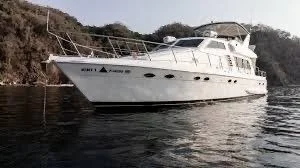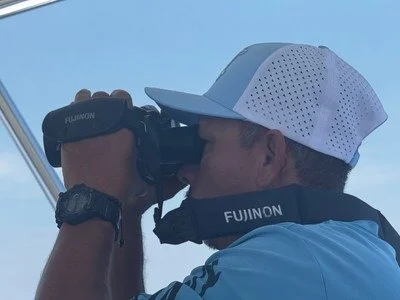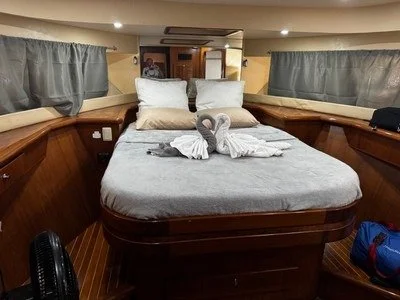Chapter 37: Day One at Sea
Aboard the 68-foot Motor Yacht Kiki I
Chapter 37: Day One at Sea
Tuesday, March 11, 2025
Our vessel—Patrick calls it the “mother ship”—is the Kiki II, a 68’ H-Class Montefino Motor Yacht built in 1996 and fully overhauled between 2021 and 2023. She sports four air-conditioned cabins with private bathrooms, a terrace for lounging, a full kitchen and Bluetooth sound system and, important for us, a full-service dive deck. Important for this blog, she also offers up Starling high speed internet with 300 GB of data included. Here is Kiki I's YouTube video: https://youtu.be/kSWkUmNA3qw
She comes equipped with underwater scooters which we will ride at the dolphins’ speed. “The dolphins love following the scooters and will stay nearby,” Patrick wrote, “playing, feeding and sometimes hunting.” OK. I’m in.
We also have a subwing, a towable device consisting of two wings mounted together which can be tilted independently of each other to mimic, well, the flight of an aircraft under water. We’ve also got a zodiac, a small RIB—Rigid Inflatable Boat “in order to be nimble around the dolphins.” We are five days and four nights at sea aboard Kiki I.
Are we harming these dolphins by interacting with them? The U.S. Marine Mammal Protection Act says that swimming with resting spinner dolphins may constitute harassment. The law says that any act of pursuit, torment or annoyance that has the potential to disrupt a marine mammal’s behavior is against the law. In Hawaii, a 2021 law prohibits swimming with, approaching or remaining within 50 yards of a Hawaiian spinner dolphin. Here, the dolphins aren’t resting when we are around them. Not even close. This is more like a dolphin frenzy. Everyone involved indicates that they seem to love interacting with humans, experiencing joyful-like behaviors. As I experienced last month in the Baja where gray whales approached and made contact, so it is here with these dolphins, I am told. They are drawn to us. They play with other species as well—humpback whales, seals, birds and turtles.
This first day at sea officially began at 9:15 when we went under way from the Puntarenas marina. Making our way in the channel, through passages and ultimately up the coast, we motored for a bit over five hours, towing our tender, the Valencia I, a fiberglass 25’ Costa Sport powered by twin 150 Yamahas, behind.
We five adventurers got acquainted. We are five guys; an actor/Botswana safari camp owner, a software expert, a trans-ocean logistician, an investment guy and the other—I don’t remember.
They are all thirty years younger than I am, still working, with younger families. Two are South Africans living in London. Our crew assisting Patrick consists of a captain, a mate, a cook and a guide/fisherman/tender boat captain.
We pass few other vessels but one is remarkable—a very large yacht with a tender full of toys. There are fishermen in pangas and panga-like boats who have come from I don’t know where but their trips to this spot in open water must have been a long one. Thankfully, the seas are calm (not flat) with swells hardly worth mentioning.
Patrick, without warning, sounded the alarm: “Get Ready.” Our team had spotted lots of birds—boobies mostly—swarming far ahead. That happens because there is food near the surface of the water. Where there is food near the surface, there are tuna and there are dolphins.
Then we were on them. A couple of hundred spinner dolphins were ahead at twelve o’clock. There is no mistaking them when you and they meet. The water is frothy with them as they bob and weave, surface to take a quick breath of air and then take a shallow dive to hunt for food. And the thing that makes them Costa Rican Spinner Dolphins, their signature move, identifies for anyone and everyone: they leap high into the air, spinning round and round like a top before falling back into the ocean with a splash as an exclamation point for their acrobatic achievement. I was too busy enjoying the show to bother with taking pictures. You get the gist of it from the earlier movie anyway—it was just like that but with many fewer participants.
We tossed the two scooters—SeaBobs—overboard and our first two adventurers leapt in after them. Operating a SeaBob is relatively simple. With your belly atop the body of the scooter, your right hand on a trigger handle and your left hand opposite on another triggerless handle, you set off by using your right thumb to tap a button. There are five speeds available. One tap is slow, another tap speeds you up and you hit max speed with five sequential taps. There is another button adjacent to your left thumb. One tap reduces your speed by one step. Don’t let go of the trigger with your right hand. If you do, you come to an abrupt stop.
By adjusting your body backwards on the scooter, its nose rises and you can make maximum speed in whatever direction your body lean takes you. When you are in the vicinity of dolphins or tuna or whatever, you shift your body forward and the nose of the scooter settles downward. You are wearing a mask and have a snorkel in your mouth. As the front of the scooter dips, your mask is in the water and a beautiful blue underwater vista overtakes you. And you find that you are not alone.
We took turns, two out and then back, switch with two more out and back and then the last two—that was Patrick and me—in the water. These dolphin were crafty. First they were here and then they were not. Over there, then over there, then, well, nowhere. On my first turn, I got comfortable with operating the SeaBob. On my second turn, I was in the midst of a school of tuna. Even though I saw hundreds of dolphin from the surface, I was denied while in the water. For me, that will come tomorrow or the next day. My shipmates all had dolphin encounters in the water; some fleeting and some long-lasting. We are all happy.
After three ten to fifteen minute runs in the water, the SeaBob batteries are running low. We haul them into the tender vessel and then return to the Kiki II. Our tender captain wants to catch one of the tuna surrounding us for our dinner. My four new friends accompany him while Patrick and I return to the mothership and begin recharging the SeaBobs. Kiki II has a fresh water hose on the stern where you can rinse the salt water from your hair, clothes and body and then, well, relax.
As I write this after changing into dry clothes, it is 5:30pm and we are far from land. The sun is close to leaving us for the day. (I did see a green flash as it went down). And then, just when I thought the day was over, we happened upon a massive flock of birds in a feeding frenzy on the surface. “That’s a bait ball,” Patrick yelled. Worn out, I enjoyed it from the bridge while three of my fellow adventurers lept off the side to enjoy the show from under the surface of the water. Tuna everywhere. They came back to Kiki II with smiling faces.
After cutting the diesel engine, we set a sea anchor—a parachute type device—to create drag in the water and keep us from drifting too many miles from here on the open ocean. Welcome quiet envelopes us. There is no ambient light so the sky above becomes the evening’s entertainment.
It was a fine first day. Noticing my writing, Patrick offers to fire up the Starlink system so that I can post this entry. There is not much in the way of supporting photography today because of the upload limitations. I apologize for that. I’ll make up for it when we get back to dry land—three days from now.











